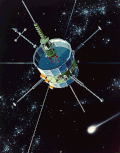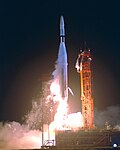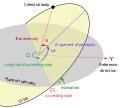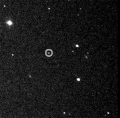A heliocentric orbit (also called circumsolar orbit) is an orbit around the barycenter of the Solar System, which is usually located within or very near...
4 KB (383 words) - 00:11, 6 February 2025
Heliocentrism (redirect from Heliocentric model)
Heliocentrism (also known as the heliocentric model) is a superseded astronomical model in which the Earth and planets orbit around the Sun at the center...
102 KB (12,077 words) - 18:12, 31 May 2025
galaxy. The Sun follows this type of orbit about the Galactic Center of the Milky Way. Heliocentric orbit: An orbit around the Sun. In the Solar System...
31 KB (3,455 words) - 19:37, 27 October 2024
List of objects at Lagrange points (redirect from Earth-trailing orbit)
diverted out of L1 in 1983 for a comet rendezvous mission. Currently in heliocentric orbit. The Sun–Earth L1 is also the point to which the Reboot ISEE-3 mission...
39 KB (2,597 words) - 10:24, 15 April 2025
halo orbits, orbits around the Sun-Earth Lagrange points, with orbits increasingly being heliocentric, co-orbiting with Earth the Sun before orbits go deeper...
9 KB (790 words) - 11:14, 26 April 2025
is a list of artificial objects currently[update] in heliocentric orbit, but not intended to orbit or land on any planetary or satellite body. This list...
8 KB (882 words) - 12:19, 21 April 2025
Copernican heliocentrism (redirect from Heliocentric theory of the solar system)
cosmos. Thus, his heliocentric model retained several of the Ptolemaic elements, causing inaccuracies, such as the planets' circular orbits, epicycles, and...
42 KB (5,235 words) - 02:05, 22 May 2025
International Cometary Explorer (category Spacecraft using halo orbits)
Explorer-3 (ISEE-3) satellite, was launched on 12 August 1978 into a heliocentric orbit. It was one of three spacecraft, along with the mother/daughter pair...
32 KB (3,299 words) - 14:43, 21 March 2025
orbit for an orbit around Earth and heliocentric orbit for an orbit around the Sun. As with these other orbits, the apsides of an areocentric orbit are...
2 KB (204 words) - 16:19, 5 November 2024
Earth orbits the Sun at an average distance of 149.60 million km (92.96 million mi), or 8.317 light-minutes, in a counterclockwise direction as viewed...
17 KB (1,860 words) - 12:44, 24 March 2025
to operate in heliocentric orbit or at one of the Earth–Sun Lagrangian points – additional solar observatories were placed in Earth orbit and are not included...
133 KB (2,007 words) - 13:54, 28 May 2025
lunar flyby, a Tesla Roadster demonstration payload to a heliocentric orbit extending past the orbit of Mars, DART and Hera to the asteroid Didymos, Euclid...
586 KB (21,455 words) - 21:19, 1 June 2025
Earth's orbit List of orbits Orbital mechanics Celestial sphere Heliocentric orbit Areosynchronous orbit Areostationary orbit Escape velocity Satellite...
17 KB (1,997 words) - 15:59, 21 April 2025
Apollo Lunar Module (category Spacecraft that orbited the Moon)
(Apollo 10's Snoopy) was discarded in a heliocentric orbit after its descent stage was discarded in lunar orbit. The other three LMs were destroyed during...
66 KB (6,466 words) - 21:41, 13 May 2025
2017 OF201 (section Orbit)
close to spherical. Given the orbital eccentricity of this object, different epochs can generate quite different heliocentric unperturbed two-body best-fit...
14 KB (1,120 words) - 21:27, 1 June 2025
Escape velocity (category Orbits)
is useful to know whether a probe will continue to orbit the Earth or escape to a heliocentric orbit. It is also useful to know how much a probe will need...
28 KB (3,648 words) - 13:53, 3 February 2025
liftoff. Mariner 2 – Defunct after successful mission, occupies a heliocentric orbit. Sisterships Mariner 3 and Mariner 4 were Mars flyby missions. Mariner...
24 KB (2,437 words) - 19:51, 11 March 2025
term geocentric orbit for an orbit around Earth and heliocentric orbit for an orbit around the Sun. The apsides of an Cytherocentric orbit are pericytherion...
6 KB (631 words) - 23:58, 23 May 2025
orbit (LEO). Heavy-lift launch vehicles often carry payloads into higher-energy orbits, such as geosynchronous transfer orbit (GTO) or heliocentric orbit...
28 KB (1,937 words) - 11:48, 4 May 2025
System, a heliocentric reference frame (relative to the gravitational center of the Sun) is sufficient to explain their orbits. However, as the orbits of objects...
28 KB (1,669 words) - 09:19, 29 May 2025
with each side 2.5 million kilometers long, flying in an Earth-like heliocentric orbit. The distance between the satellites is precisely monitored to detect...
59 KB (5,410 words) - 21:56, 16 May 2025
Elon Musk's Tesla Roadster (category Derelict satellites in heliocentric orbit)
an escape trajectory and entered an elliptical heliocentric orbit crossing the orbit of Mars. The orbit reaches a maximum distance from the Sun at aphelion...
66 KB (5,251 words) - 06:19, 27 May 2025
tasks:: 42 Orbit manoeuvres to transfer the spacecraft from Earth-centred orbit to heliocentric trajectory and finally, capture into Martian orbit Development...
106 KB (9,122 words) - 01:04, 24 May 2025
space probes which have escaped Earth orbit. It includes lunar space probes, but does not include space probes orbiting at the Sun–Earth Lagrangian points...
20 KB (2,080 words) - 13:51, 28 May 2025
J-2 rocket engine. For lunar missions it was fired twice: first for Earth orbit insertion after second stage cutoff, and then for translunar injection (TLI)...
18 KB (1,157 words) - 01:33, 11 May 2025
For a geocentric orbit, Earth's equatorial plane. In this case, non-inclined orbits are called equatorial. For a heliocentric orbit, the ecliptic or invariable...
9 KB (951 words) - 00:40, 25 May 2025
Argument of periapsis (category Orbits)
specific types of orbits, terms such as argument of perihelion (for heliocentric orbits), argument of perigee (for geocentric orbits), argument of periastron...
4 KB (565 words) - 00:23, 24 September 2024
Apsis (category Orbits)
nearest point in a heliocentric orbit. Earth's two apsides are the farthest point, aphelion, and the nearest point, perihelion, of its orbit around the host...
42 KB (3,925 words) - 13:39, 30 May 2025
J002E3 (category Derelict satellites in heliocentric orbit)
injected into a permanent heliocentric orbit in November 1969, but is now believed instead to have gone into an unstable high Earth orbit which left Earth's...
12 KB (1,263 words) - 22:17, 13 December 2024
captured from heliocentric orbit. Triton is unusual as it is the only known large moon on a retrograde, highly-inclined orbit; that is, Triton orbits in the...
23 KB (2,701 words) - 02:17, 10 March 2025

























